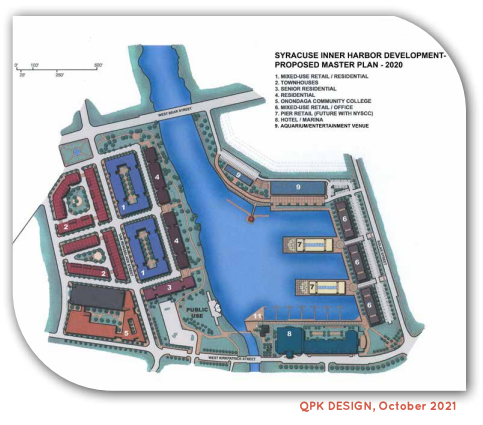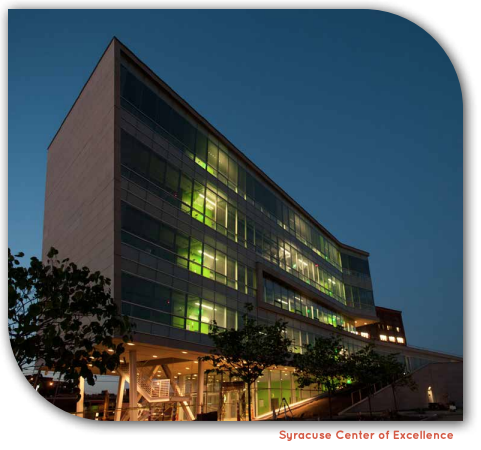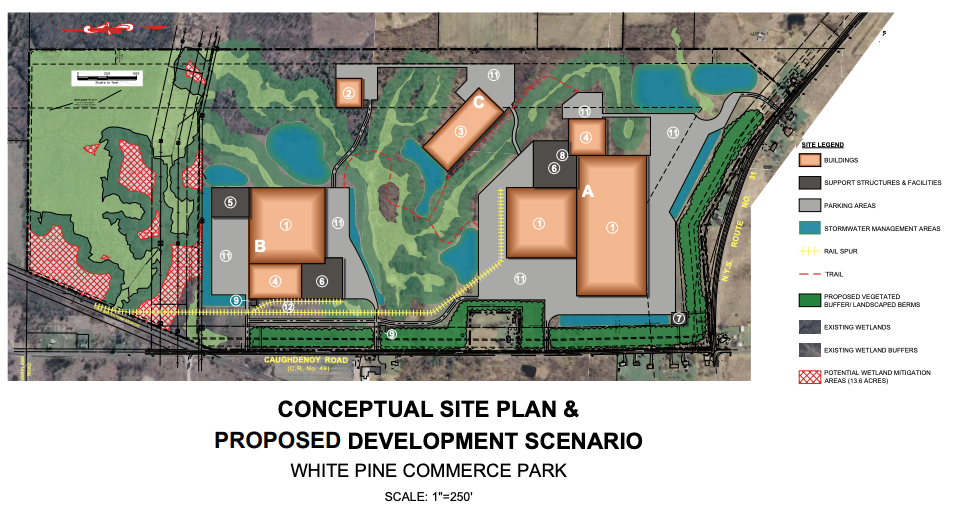economic development
Regional economic development plans
The Central New York community has a very diverse economy that is supported by a growing workforce, a well-developed infrastructure base, and strong academic resources. To capitalize on these assets, the region has completed studies and developed a number of strategic economic development plans in recent years which together represent a short-term economic development strategy and a long-term comprehensive approach to economic growth.
These documents include a report issued in 2007 by Battelle regarding the opportunities and prospects for Upstate New York’s “green” industry sector. Other important reports include the CNY Comprehensive Economic Development Strategy (CNY CEDS), Vision 2010: A Regional Economic Development Strategy for Syracuse and Central New York, and the Essential New York Initiative. The CNY CEDS is a document updated each year by the CNY Regional Planning and Development Board and focuses on a short-term project priority list of public capital improvement projects for the region. Vision 2010 is a document that was prepared in 1996 by the Stanford Research Institute under contract with the Metropolitan Development Association of Syracuse and Central New York. The revisions to Vision 2010, titled the Essential New York Initiative, were prepared in 2004 by the Battelle Institute and Catalytix (a Richard Florida Company), two nationally-recognized consultants retained by MDA.
In 2011, these planning efforts received additional support from New York State through the implementation of a regional economic development council program initiative. As part of this initiative, each regional council was tasked with the challenge of preparing a regional economic development plan for their respective region.
The Central New York Regional Economic Development Council (CNY REDC) completed work on their Five-Year Strategic Plan: 2012–2016 in November 201. This plan was chosen by the Governor’s office in December 2011 as the “Best Plan Awardee” in NYS and received $103.7 million in capital grants and tax credit financing to support a range of

economic and community development projects in the five-county Central New York region. Complementing this work, was an updated plan issued by the CNY REDC in 2015 titled, CNY Rising from the Ground Up. This plan was the basis for a $350 million award to the region through the NYS Upstate Revitalization Initiative.
The CNY REDC’s strategic plans are built around three priority goals to guide the region’s collective actions:
- Strengthen Targeted Industry Concentrations that Leverage Unique Economic Assets
- Improve Competitiveness in, and Connections to, the Regional, National, and Global Economies
- Revitalize the Region’s Urban Cores, Main Streets, and Neighborhoods
A. Strengthen Targeted Industry Concentrations that Leverage Unique Economic Assets
In planning for future prosperity, the CNY REDC identified several critical industry concentrations that are at the heart of its economic strategy. These sectors represent a cross-section of both traditional and new economy industries and share five common criteria:
- they have critical mass of existing firms and a large base of existing employment in the region;
- employment in these sectors is highly concentrated in Central New York;
- there is significant growth in regional, national, and global demand for the products and services they generate;
- Central New York possesses resources to support these clusters and, therefore, this region has a competitive advantage to attract similar firms;
- they are deeply connected to our anchor institutions.
Priority industry concentrations identified in the plan include:
- Clean Energy and Environmental Systems—Central New York has the eighth highest concentration of private sector “green jobs” of any region in the country and is home to New York State’s Syracuse Center of Excellence in Environmental and Energy Systems (SyracuseCoE), a consortium of more than 200 research institutions and private sector companies.
- Health, Biomedical Services, and Biosciences— The region’s hospitals directly employ more than 23,000 people and another 3,500 are employed in private, high-tech biomedical companies with average wages approaching $70,000, nearly double the region’s median wage. The region’s extensive research and development (R&D) in the biosciences cluster not only fuels health and biomedical, but also drives the area’s clean technology, agribusiness, and other core industries.
- Financial Services—This industry employs more than 24,000 in the region. Recent research demonstrates that Central New York offers significant advantages to firms in this sector, such as a lower cost of operation and a highly skilled and experienced labor force that provides opportunities for employment growth.

4. Agribusiness and Food Processing—New York State is the nation’s third-largest producer of fluid milk and commodity crops representing more than $1 billion in sales alone. Central New York is a significant contributor and increasingly focused on value-added opportunities for agribusiness, including food processing.
5. Advanced Manufacturing—Manufacturing represents 10% of the region’s total employment and subsectors, such as digital electronics and radar and sensor systems, serve expanding global markets in security, information technology, and defense.
6. Tourism—Tourism is a $1 billion industry in Central New York, and current global economic conditions, including the weak dollar, create opportunities for the region to draw additional international visitors across our shared boundary with Canada and from entry points downstate.
B. Improve Competitiveness in, and Connections to, the Regional, National, and Global Economies
The CNY REDC’s economic development strategy acknowledges and embraces the global nature of today’s economy and encourages businesses, large and small, to compete in an increasingly competitive marketplace. As noted in the plan, Central New York’s highly educated workforce forms the foundation for those investments, as does its unique concentration of leading higher-education and research and development institutions. In order to improve global competitiveness, the plan recommends making significant investments in several critical mechanisms that fuel economic growth:
- Encourage New Venture and Product Development—The region has a strong foundation in entrepreneurship with collaborative programs between higher education and business. Further investments in this area are recommended to support successful venture development, including student venture development, as part of a transformational strategy to re-energize the regional economy
- Prioritize Investments in Innovation, Commercialization, and Process Improvement—Continuous improvement and the development of new products and services is critical to the success of businesses in a rapidly evolving global economy. The CNY REDC recommends private investment in research and development; improve technology commercialization among its educational and research institutions; and the creation of a complete ecosystem of mentors, business services, and risk-capital to enable innovation.
- Capture a Greater Share of the Global Marketplace—Ninety-five percent of the world’s consumers currently reside outside of the United States. Improving export performance is critical to the longterm competitiveness of the region. Export-driven jobs also provide higher wages for the region’s residents. In addition to promoting Central New York’s products and services across the world, the region is well positioned to attract new foreign investment from global companies looking to serve domestic markets.
- Build a 21st Century Infrastructure—Global competitiveness requires global connectivity. The region must improve its physical infrastructure, including its air service, port access, road and rail infrastructure, and broadband connectivity, in order to get regional goods and services to national and global markets.
- Maximize Human Capital—While the region possesses a highly skilled and well-educated workforce, the region must expand the participation of the workforce in the new economy, particularly in key industry sectors, such as advanced manufacturing and health care.

C. Revitalize the Region’s Urban Cores, Main Streets, and Neighborhoods
As part of the plan, the CNY REDC recognized that strong regions are built around strong municipal cores and neighborhoods that develop, attract, and retain the human and social capital required for industry to grow and remain competitive—the convergence of ideas and people. Many leading businesses and key industry sector hubs are located within these city and town centers, and the region’s anchor institutions—educational, health care, and cultural— have been at the forefront of the national movement to leverage their assets for community revitalization. Building upon the strengths of these existing opportunities, the CNY REDC recommends that efforts be directed to recreate the social, physical, and cultural fabric of its neighborhoods, urban cores, and main streets. In pursuing the goal to invest in and strengthen the region’s cores, the CNY REDC recommended:
- Rethink—Reinvigorate the region’s neighborhoods and main streets through mutually beneficial partnerships with diverse businesses and the region’s anchor institutions, and invest resources that leverage the national movement of anchor institutions to restore neighborhoods, train new workers, retain young talent, and create small business and social enterprises.
- Repurpose—Municipal centers represent significant investments in physical infrastructure that must be preserved and enhanced for future growth. Pursue a strategy that repurposes existing physical assets through adaptive re-use and brownfield remediation, links planned transportation investment with surrounding private development through transit-oriented strategies, uses green technologies to improve the efficiency of existing assets from individual buildings to entire neighborhoods, promotes density in development, and encourages quality communities.
- Retrain—Human and social capital is the most important asset for a globally competitive economy, and the region must rise to the challenge to improve Pre-K-12 educational attainment; provide greater access to education; prepare students for high-demand careers; retrain workers for new careers; support minority, women, and veteran owned businesses; and create quality employment opportunities that will allow individuals and families to prosper.
D. Next Steps in Building the Foundation for Transformative Prosperity
Although the region’s strategic plans are largely developed to address immediate economic development opportunities, these plans also identify “transformational” projects, programs, and other opportunities that are critical for the region’s future. Transformational initiatives identified include:
a. Regional Industrial Clusters: New York Energy Regional Innovation Cluster (NYE-RIC)—NYE-RIC is a statewide alliance focused on accelerating the development and deployment of innovations to dramatically improve energy efficiency in buildings, addressing a global demand in a market that is expected to grow dramatically over the coming decades. The proposed investment of $225 million includes $150 million from private and federal sources, which can be used to leverage $75 million from various state and federal sources.
Food-to-Market and Agricultural Programming—Central New York is uniquely poised to be the agribusiness “hub” of New York if it can coordinate its use of agricultural and natural resources to create more robust systems for local food to market initiatives and regional energy production.
Tourism in the Arts and Culture—The region has an abundance of arts and cultural opportunities, with world-class offerings by individual artist studios to large-scale performance venues. Access must be provided to broader audiences while finding ways to leverage community support and funding for the arts to reach national and international markets.
b. Connecting People, Jobs, and Housing: Municipal Core MixedUse Investment Program— The Restore New York program successfully provided needed gap financing to mixed-use projects of all sizes throughout the State. The program proved critical to getting new commercial and residential construction moving in Central New York’s municipal cores and the State must consider the creation of similar mixed-use investment programs in the future.
Broadband/Connectivity Infrastructure—In an increasingly interconnected marketplace, ubiquitous high-speed, affordable broadband Internet access is a key component to thriving economies in both urban and rural communities. Rural areas need a strategy to support investment in broadband to connect its citizens with each other and the broader economy.
Region-Wide Waterfront Revitalization Strategy— To unlock the full economic potential of the region’s abundant waterfronts, New York State must help create focused waterfront programs that leverage local investments in municipal revitalization, marketing, business recruitment, and shipping.
c. Workforce Alignment: Say Yes to Education—The nation’s first-ever, district-wide implementation of Say Yes in the City of Syracuse is a visionary, turnaround model for education and economic development in urban centers across the United States. New York State must help expand the Say Yes Summer Academies throughout the five-county region, and further advance scholarship opportunities for aspiring youth. Complementing this initiative is the City’s Smart City Surge and plans for a new STEAM regional high school.
d. Innovation Infrastructure: Innovate Upstate Fund—Central New York has a robust innovation ecosystem through R&D at major area employers and its academic institutions, and at strong early-stage companies; however, the State does not have a complete continuum of funding programs and tax breaks to assist in various emerging technology sectors. The region’s private and institutional partners must work to capitalize a regional venture fund to provide critical risk capital to accelerate the launch and growth of more start-up companies.

